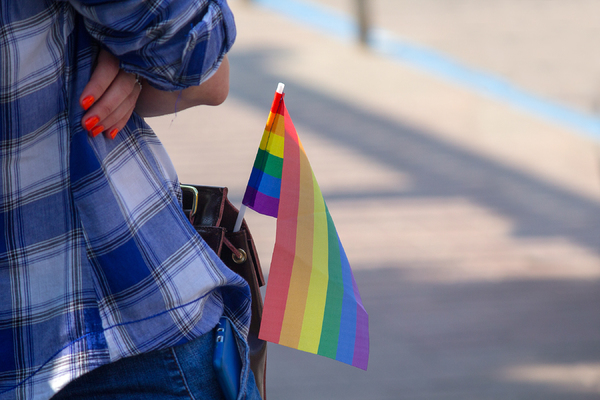Addiction and depression often go hand in hand. And in the LGBT community, incidences of these debilitating conditions rise even higher. Here’s a closer look at the dual dynamics of LGBT addiction and depression, along with treatment options aimed at helping LGBT individuals regain health and happiness.

A rainbow flag symbolizes gay pride, hope, and self-acceptance—but the association of higher rates of LGBT mental illness and substance abuse remains hidden.
The Facts
A recent report from the Substance Abuse and Mental Health Services Administration (SAMHSA) reveals that “sexual minority adults,” AKA those who identify as lesbian, gay, or bisexual, are at a greater risk of both mental illness and substance abuse than are “sexual majority adults,” AKA heterosexuals. (The report does not factor in transgender and/or questioning people because SAMHSA’s National Survey on Drug Use and Health, upon which the data is based, does not currently identify those populations in its questionnaire.)
Explains SAMHSA Deputy Principal Administrator Kana Enomoto of the research,
“This report offers unprecedented insight into the behavioral health needs of lesbian, gay, and bisexual Americans—people critical to our community whose health concerns have often been overlooked.”
Highlighting the Numbers
Specifically, SAMHSA’s findings indicate that of the 4.3 percent of the adult population who identify as lesbian, gay or bisexual, 39.1 percent, 32.2 percent, and 63.6 percent had used illicit drugs, smoked cigarettes, or drank alcohol, respectively, that year. Compare these figures to 17.1 percent, 20.6 percent, and 56 percent, respectively, for adults who identify as heterosexuals. Not only were substance abuse levels consistently higher among the former than the latter, but this was consistent across all age and gender groups.
SAMHSA identified the same phenomenon when it comes to mental illness: Lesbian, gay, and bisexual adults were more than twice as likely as heterosexual adults to have experienced mental illness in the preceding year: 37.4 percent compared to 17.1 percent.
Understanding the Link
These alarming statistics beg the question: Why are members of the LGBT community at an increased risk for both substance abuse and mental illness?
Says Jeremy Goldbach, Ph.D., LMSW, an assistant professor at the University of Southern California School of Social Work, of the former,
“When you are a person who is under chronic stress, that chronic stress results in negative health outcomes. The mind and body may react in multiple ways, and substance abuse is one of those ways.”
Echoes psychiatrist Eric Yarbrough M.D.,
“These illnesses can sometimes be genetic in origin, but what you often find is that, under a certain stress, these symptoms come out. Higher levels of stress can lead to substance abuse and mental illness, and sexual minority adults have often faced rejection, whether from their families, from religious organizations or through other forms of discrimination. Sometimes they even turn to alcohol or drugs to self-medicate.”
The Treatment Imperative
The good news, according to SAMHSA findings, is that sexual minority adults are also more likely to receive necessary treatments for both substance abuse and mental illness than their sexual majority counterparts.
Unfortunately, the percentages of people who seek help remain shockingly low across all demographics. Just 15.3 percent of sexual minority adults in need of substance abuse treatment received it (compared to 10.6 percent of sexual majority adults). The numbers were slightly more promising when it comes to mental illness treatment: 48.5 percent versus 42.6 percent.
Says Yarbrough,
“I hope we can take that as good news, that people are becoming more comfortable visiting health experts. On the other side of the coin, it could mean that those who are not as accepted by their families for other social conditions are turning to their healthcare provider to fill those roles.”

For LGBT addiction and depression, there is a route to recovery—with the right approach.
While the more complex social reasons behind addiction and depression in the LGBT population are sometimes written off as unimportant, the reality is that they are very relevant to recovery. In talking about prevention programs for at-risk LGBT youth, Goldman explains,
“Prevention programs work, but they only really work if the kid feels it’s culturally relevant and it matches them. When we do tailor an intervention, where kids see people and things in those programs that are similar to them, they’re more engaged, and the engagement leads to more skills development, which leads to less drug use.”
The same principle applies to LGBT adults and treatment, which is why specialized treatment programs aimed at meeting their unique needs offer the greatest chances of success.
We’re Here to Help
Contact us at Harris House today to learn about how our LGBT addiction programs are targeted to help LGBT addicts and their families recover and heal.







